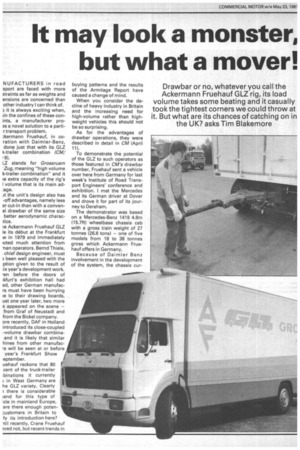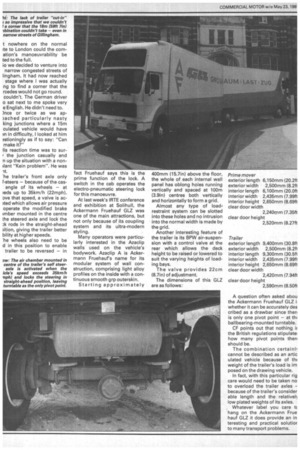It may look a monster, but what a mover!
Page 44

Page 45

Page 46

If you've noticed an error in this article please click here to report it so we can fix it.
NUFACTURERS in road sport are faced with more 3traints as far as weights and ensions are concerned than other industry I can think of. ) it is always exciting when, in the confines of these conints, a manufacturer proes a novel solution to a parti r transport problem.
-.;kermann Fruehauf, in coration with Daimler-Benz, done just that with its GLZ k-trailer combination (CM,' '9).
LZ stands for Grossruam • Zug, meaning "high volume k-trailer combination" and it le extra capacity of the rig's I volume that is its main ad:age.
At the unit's design also has -off advantages, namely less er cut-in than with a convenel drawbar of the same size better aerodynamic charactics.
le Ackermann Fruehauf GLZ le its debut at the Frankfurt w in 1979 and immediately feted much attention from -nan operators. Bernd Thiele, chief design engineer, must ) been well pleased with the ption given to the result of ,ix year's development work. 'en before the doors of ,kfurt's exhibition hall had ed, other German manufacrs must have been hurrying le to their drawing boards, ust one year later, two more
s appeared on the scene — from Graf of Neustadt and from the Bickel company. ore recently, OAF in Holland introduced its close-coupled -volume drawbar combineand it is likely that similar hines from other manufacrs will be seen at or before year's Frankfurt Show / eptember.
uehauf reckons that 80 cent of the truck-trailer binations it currently ; in West Germany are I he GLZ variety. Clearly
there is considerable and for this type of cle in mainland Europe, are there enough poten.3ustomers in Britain to fy its introduction here? itil recently, Crane Fruehauf 3ved not, but recent trends in
buying patterns and the results of the Armitage Report have caused a change of mind.
When you consider the decline of heavy industry in Britain and the increasing need for high-volume rather than highweight vehicles this should not be so surprising.
As for the advantages of drawbar operations, they were described in detail in CM (April 11).
To demonstrate the potential of the GLZ to such operators as those featured in CM's drawbar number, Fruehauf sent a vehicle over here from Germany for last week's Institute of Road Transport Engineers' conference and exhibition. I met the Mercedes and its German driver at Dover and drove it for part of its journey to Dereham.
The demonstrator was based on a Mercedes-Benz 1419 4.8m (15.7ft) wheelbase chassis cab with a gross train weight of 27 tonnes (26.6 tons) — one of five models from 18 to 38 tonnes gross which Ackermann Fruehauf offers in Germany.
Because of Daimler Benz involvement in the development of the system, the chassis cur rently used by AF are exclusively from that manufacturer.
Three patents have been applied for: the telescopic drawbar and trailer steering by Ackermann Fruehauf, and the electro pneumatic locking device for the trailer's steering axle by Daimler-Benz.
It seems that if British operators come out strongly in favour, Daimler-Benz will soon engineer a right-hand-drive version with braking and lighting to suit C and U regulations.
Much of the equipment fitted to our demonstration vehicle is optional and an operator can specify as much or as little as he wants. The cab roof-mounted sleeper compartment, for example, could simply be left out altogether or replaced if required with a roof-mounted air deflector.
But if you need a sleeper and the maximum length of II space, the roof-mounted cc partment is the answer. Cc pared with a conventio sleeper cab, it allows an e) 0.5m (1.6ft) of platform lengti be used. A further 0.9m (2.9 of usable body length is gal/ by the close coupling of veh and trailer with 0.9m (2.3ft) c gap as against the normal ft drawbar of 1.6m (5.2ft).
The net result is a total I( volume of 100cum (3,571cuft; capacity as big as this on an 1 combination has been achie, before, by Silentnight Ltd (( April 11), but that was only p sible with demountable hoc which could exceed the rru mum length by 0.3m (1ft) with an internal height of 2.8 (9ft 6in).
The Ackermann Fruehauf dies have an internal height 2.65m within an overall unlac height of less than 4.0m (13.11 Matching the height of sleeper pod to the height of body, an air dam underneath front bumper and additio streamlining of the door a side panels helps to keep drag coefficient low — or as American Fruehauf corporat would perhaps put it, "cont utes to the airflow managem package".
Contributing to the same pa age are the flaps on the be work of the towing vehicle wh effectively eliminate the area turbulence between it and trailer and the skirts on the be work of both truck and trailer.
The result, says Fruehauf, i drag coefficient for the tri trailer combination of 0.4-0. compared with the usual fig for an umodified comparable of 0.8-1.5.
From a driver's viewpoint, sleeper pod makes the alrei spacious Mercedes cab e■ more roomy. But, it was manoeuvrability of the Ad. mann Fruehauf GLZ that re impressed.
The first few corners on road through Dover were ne tiated gingerly, having reg for the 18m (59ft) length of vehicle and the time taken adapt to left-hand drive.
But by carefully watching rearview mirrors as we sw. left and right through the .4 roundabouts, I quickly app ciated just how closely the tra followed the truck.
I knew that a drawbar was L ter in this respect than an ar but the GLZ's performance ceeded expectations. By time we had reached Cani bury, I came to the conclus
I nowhere on the normal ite to London could the cornation's manoeuvrability be led to the full.
■ o we decided to venture into narrow congested streets of lingham. It had now reached stage where I was actually ng to find a corner that the rcedes would not go round. couldn't. The German driver o sat next to me spoke very e English. He didn't need to. )nce or twice as we ap)ached particularly nasty king junctions where a 15m culated vehicle would have :n in difficulty, I looked at him 3stioningly as if to say: "Can make it?"
us reaction time was to surr the junction casually and n up the situation with a nondant "Kein problem". He was 'he trailer's front axle only [-steers — because of the casangle of its wheels — at :eds up to 35km/h (22mph). Dve that speed, a valve is acted which allows air pressure operate the modified brake imber mounted in the centre the steered axle and lock the
rods in the straight-ahead iition, giving the trailer better bility at higher speeds.
Tie wheels also need to be d in this position to enable trailer to be reversed — in fact Fruehauf says this is the prime function of the lock. A switch in the cab operates the electro-pneumatic steering lock for this manoeuvre.
At last week's IRTE conference and exhibition at Solihull, the Ackermann Fruehauf GLZ was one of the main attractions, but not only because of its coupling system and its ultra-modern styling. • Many operators were particularly interested in the Azaclip walls used on the vehicle's bodywork. Azaclip A is Ackermann Fruehauf's name for its modular system of wall construction, comprising light alloy profiles on the inside with a continuous smooth grp outerskin.
Starting approximately 400mm (15.7in) above the floor, the whole of each internal wall panel has oblong holes running vertically and spaced at 100m (3.9in) centres both vertically and horizontally to form a grid.
Almost any type of loadrestraint system can be slotted into these holes and no intrusion into the normal width is made by the grid.
Another interesting feature of the trailer is its BPW air-suspension with a control valve at the rear which allows the deck height to be raised or lowered to suit the varying heights of loading bays.
The valve provides 22cm (8.7in) of adjustment.
The dimensions of this GLZ are as follows:
Prime mover
exterior length 6,150mm (20.2f1 exterior width 2,500mm (8.211 interior length 6,100mm (20.0f1 interior width 2,435mm (7.99f1 interior height 2,650mm (8.69f1 clear door width 2,240enm (7.35ft clear door height 2,520mm (8.27ft Trailer exterior length 9,400mm (30.8f1 exterior width 2,500mm (8.2fi interior length 9,300mm (30.5f1 interior width 2,435mm (7.99f1 interior height 2,650mm (8.69f1 clear door width 2,420mm (7.94f1 clear door height 2,590mm (8.50ft
A question often asked abou the Ackermann Fruehauf GLZ i. whether it can be accurately des cribed as a drawbar since then is only one pivot point — at thi ballbearing-mounted turntable.
CF points out that nothing ir the British regulations stipulate: how many pivot points then should be.
The combination certainl■ cannot be described as an artic ulated vehicle because of tilt weight of the trailer's load is im posed on the drawing vehicle.
In fact, with this particular rig care would need to be taken no to overload the trailer axles because of the trailer's consider able length and the relativel) low plated weights of its axles.
Whatever label you care tc hang on the Ackermann Frue hauf GLZ it does provide an in teresting and practical soiutior to many transport problems.




































































































